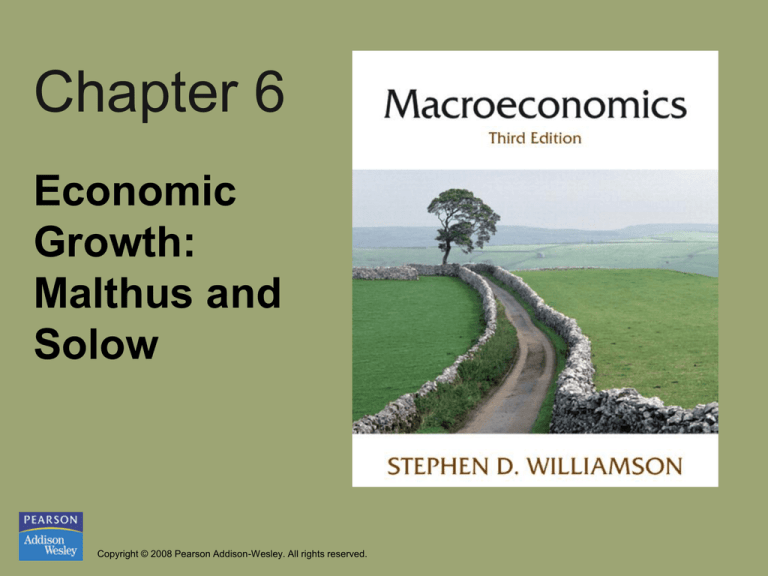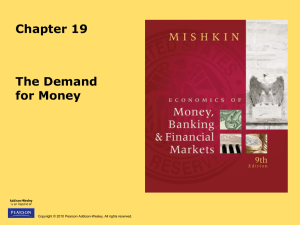
Chapter 6
Economic
Growth:
Malthus and
Solow
Copyright © 2008 Pearson Addison-Wesley. All rights reserved.
Chapter 6 Topics
•
•
•
•
Economic growth facts
Malthusian model of economic growth
Solow growth model
Growth accounting
Copyright © 2008 Pearson Addison-Wesley. All rights reserved.
6-2
U.S. Per Capita Income Growth
In the United States, growth in per capita income
has not strayed far from 2% per year (excepting
the Great Depression and World War II) since
1900.
Copyright © 2008 Pearson Addison-Wesley. All rights reserved.
6-3
Figure 6.1 Natural Log of Real PerCapita Income in the United States,
1869–2005
Copyright © 2008 Pearson Addison-Wesley. All rights reserved.
6-4
Real Per Capita Income and the
Investment Rate
Across countries, real per capita income and the
investment rate are positively correlated.
Copyright © 2008 Pearson Addison-Wesley. All rights reserved.
6-5
Figure 6.2 Real Income Per
Capita vs. Investment Rate
Copyright © 2008 Pearson Addison-Wesley. All rights reserved.
6-6
Real per capita income and the
rate of population growth
Across countries, real per capita income and the
population growth rate are negatively correlated.
Copyright © 2008 Pearson Addison-Wesley. All rights reserved.
6-7
Figure 6.3 Real Income Per Capita vs.
the Population Growth Rate
Copyright © 2008 Pearson Addison-Wesley. All rights reserved.
6-8
Real per capita income and per
capita income growth
• There is no tendency for rich countries to grow
faster than poor countries, and vice-versa.
• Rich countries are more alike in terms of rates of
growth than are poor countries.
Copyright © 2008 Pearson Addison-Wesley. All rights reserved.
6-9
Figure 6.4 Growth Rate in Per Capita
Income vs. Real Income Per Capita for
the Countries of the World
Copyright © 2008 Pearson Addison-Wesley. All rights reserved.
6-10
A Malthusian Model of
Economic Growth
Model predicts that a technological advance will
just increase population, with no long-run
change in the standard of living.
Copyright © 2008 Pearson Addison-Wesley. All rights reserved.
6-11
Equation 6.1: Production
Function
Output is produced from land and labor inputs.
Copyright © 2008 Pearson Addison-Wesley. All rights reserved.
6-12
Equation 6.2: Evolution of the
population
Population growth is higher the higher is percapita consumption.
Copyright © 2008 Pearson Addison-Wesley. All rights reserved.
6-13
Equation 6.3: Equilibrium
Condition
In equilibrium, consumption equals output
produced.
Copyright © 2008 Pearson Addison-Wesley. All rights reserved.
6-14
Equation 6.4: Equilibrium
evolution of the population
This equation describes how the future population
depends on current population.
Copyright © 2008 Pearson Addison-Wesley. All rights reserved.
6-15
Figure 6.5 Population Growth
Depends on Consumption per Worker
in the Malthusian Model
Copyright © 2008 Pearson Addison-Wesley. All rights reserved.
6-16
Equation 6.5
Copyright © 2008 Pearson Addison-Wesley. All rights reserved.
6-17
Figure 6.6 Determination of the
Population in the Steady State
Copyright © 2008 Pearson Addison-Wesley. All rights reserved.
6-18
Equation 6.6: The per-worker
production function
Copyright © 2008 Pearson Addison-Wesley. All rights reserved.
6-19
Equation 6.7: Equilibrium
condition in per-worker form
Copyright © 2008 Pearson Addison-Wesley. All rights reserved.
6-20
Equation 6.8
Population growth is increasing in consumption
per worker, c
Copyright © 2008 Pearson Addison-Wesley. All rights reserved.
6-21
Figure 6.7 The Per-Worker
Production Function
Copyright © 2008 Pearson Addison-Wesley. All rights reserved.
6-22
Figure 6.8 Determination of the
Steady State in the Malthusian Model
Copyright © 2008 Pearson Addison-Wesley. All rights reserved.
6-23
An increase in z in the
Malthusian model
• If z increases, this shifts up the per-worker
production function.
• In the long run, the population increases to the
point where per capita consumption returns to its
initial level.
• There is no long-run change in living standards.
Copyright © 2008 Pearson Addison-Wesley. All rights reserved.
6-24
Figure 6.9 The Effect of an Increase in
z in the Malthusian Model
Copyright © 2008 Pearson Addison-Wesley. All rights reserved.
6-25
Figure 6.10 Adjustment to the Steady
State in the Malthusian Model When z
Increases
Copyright © 2008 Pearson Addison-Wesley. All rights reserved.
6-26
Population Control in the
Malthusian Model
• Population control alters the relationship
between population growth and per-capita
consumption.
• In the long run, per capita consumption
increases, and living standards rise.
Copyright © 2008 Pearson Addison-Wesley. All rights reserved.
6-27
Figure 6.11 Population Control in
the Malthusian Model
Copyright © 2008 Pearson Addison-Wesley. All rights reserved.
6-28
How Useful is the Malthusian
Model
• Model provides a good explanation for pre-1800
growth facts in the world.
• Malthus did not predict the effects of
technological advances on fertility.
• Malthus did not understand the role of capital
accumulation in growth.
Copyright © 2008 Pearson Addison-Wesley. All rights reserved.
6-29
Solow Growth Model
• This is a key model which is the basis for the
modern theory of economic growth.
• A key prediction is that technological progress is
necessary for sustained increases in standards of
living.
Copyright © 2008 Pearson Addison-Wesley. All rights reserved.
6-30
Equation 6.9: Population growth
• In the Solow growth model, population is
assumed to grow at a constant rate n.
Copyright © 2008 Pearson Addison-Wesley. All rights reserved.
6-31
Equation 6.10: ConsumptionSavings Behavior
• Consumers are assumed to save a constant
fraction s of their income, consuming the rest.
Copyright © 2008 Pearson Addison-Wesley. All rights reserved.
6-32
Equation 6.11: Representative
firm’s production function
Copyright © 2008 Pearson Addison-Wesley. All rights reserved.
6-33
Equation 6.12
Constant returns to scale implies:
Copyright © 2008 Pearson Addison-Wesley. All rights reserved.
6-34
Equation 6.13: Evolution of the
capital stock
Future capital equals the capital remaining after
depreciation, plus current investment.
Copyright © 2008 Pearson Addison-Wesley. All rights reserved.
6-35
Figure 6.12 The Per-Worker
Production Function
Copyright © 2008 Pearson Addison-Wesley. All rights reserved.
6-36
Equation 6.14: IncomeExpenditure Identity
The income expenditure identity holds as an
equilibrium condition.
Copyright © 2008 Pearson Addison-Wesley. All rights reserved.
6-37
Equation 6.15
In equilibrium, future capital equals total savings
(= I ) plus what remains of current K.
Copyright © 2008 Pearson Addison-Wesley. All rights reserved.
6-38
Equation 6.16
Substitute for output from the production function.
Copyright © 2008 Pearson Addison-Wesley. All rights reserved.
6-39
Equation 6.17
Rewrite in per-worker form.
Copyright © 2008 Pearson Addison-Wesley. All rights reserved.
6-40
Equation 6.18
Re-arrange, to get:
Copyright © 2008 Pearson Addison-Wesley. All rights reserved.
6-41
Figure 6.13 Determination of the
Steady State Quantity of Capital per
Worker
Copyright © 2008 Pearson Addison-Wesley. All rights reserved.
6-42
Equation 6.19
Equation determining the steady state quantity of
capital per worker, k*:
Copyright © 2008 Pearson Addison-Wesley. All rights reserved.
6-43
Figure 6.14 Determination of the
Steady State Quantity of Capital per
Worker
Copyright © 2008 Pearson Addison-Wesley. All rights reserved.
6-44
An increase in the savings rate, s
• In the steady state, this increases capital per
worker and real output per capita.
• In the steady state, there is no effect on the
growth rates of aggregate variables.
Copyright © 2008 Pearson Addison-Wesley. All rights reserved.
6-45
Figure 6.15 Effect of an Increase in the
Savings Rate on the Steady State
Quantity of Capital per Worker
Copyright © 2008 Pearson Addison-Wesley. All rights reserved.
6-46
Figure 6.16 Effect of an Increase
in the Savings Rate at Time T
Copyright © 2008 Pearson Addison-Wesley. All rights reserved.
6-47
Figure 6.17 Steady State
Consumption per Worker
Copyright © 2008 Pearson Addison-Wesley. All rights reserved.
6-48
Figure 6.18 The Golden Rule
Quantity of Capital per Worker
Copyright © 2008 Pearson Addison-Wesley. All rights reserved.
6-49
An increase in the population
growth rate, n
• Capital per worker and output per worker
decrease.
• There is no effect on the growth rates of
aggregate variables.
Copyright © 2008 Pearson Addison-Wesley. All rights reserved.
6-50
Figure 6.19 Steady State Effects of an
Increase in the Labor Force Growth Rate
Copyright © 2008 Pearson Addison-Wesley. All rights reserved.
6-51
Increases in Total Factor
Productivity, z
Sustained increases in z cause sustained increases
in per capita income.
Copyright © 2008 Pearson Addison-Wesley. All rights reserved.
6-52
Figure 6.20 Increases in Total Factor
Productivity in the Solow Growth Model
Copyright © 2008 Pearson Addison-Wesley. All rights reserved.
6-53
Growth Accounting
An approach that uses the production function and
measurements of aggregate inputs and outputs to
attribute economic growth to: (i) growth in
factor inputs; (ii) total factor productivity
growth.
Copyright © 2008 Pearson Addison-Wesley. All rights reserved.
6-54
Equation 6.20: Cobb-Douglas
Production Function
Copyright © 2008 Pearson Addison-Wesley. All rights reserved.
6-55
Equation 6.21
A labor share in national income of 64% gives:
Copyright © 2008 Pearson Addison-Wesley. All rights reserved.
6-56
Equation 6.22
The Solow residual is calculated as:
Copyright © 2008 Pearson Addison-Wesley. All rights reserved.
6-57
Figure 6.21 Natural Log of the
Solow Residual, 1948–2005
Copyright © 2008 Pearson Addison-Wesley. All rights reserved.
6-58
Table 6.1 Average Annual Growth
Rates in the Solow Residual
Copyright © 2008 Pearson Addison-Wesley. All rights reserved.
6-59
Figure 6.22 Percentage Deviations from
Trend in Real GDP (black line) and the
Solow Residual (colored line), 1948–2005
Copyright © 2008 Pearson Addison-Wesley. All rights reserved.
6-60
Table 6.2 Measured GDP, Capital Stock,
Employment, and Solow Residual
Copyright © 2008 Pearson Addison-Wesley. All rights reserved.
6-61
Table 6.3 Average Annual
Growth Rates
Copyright © 2008 Pearson Addison-Wesley. All rights reserved.
6-62
Table 6.4 East Asian Growth Miracles
(Average Annual Growth Rates)
Copyright © 2008 Pearson Addison-Wesley. All rights reserved.
6-63







